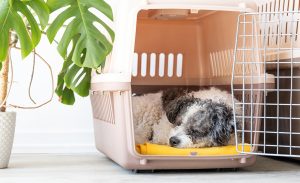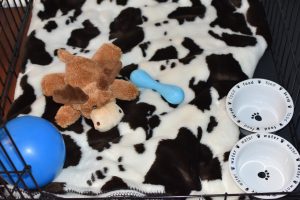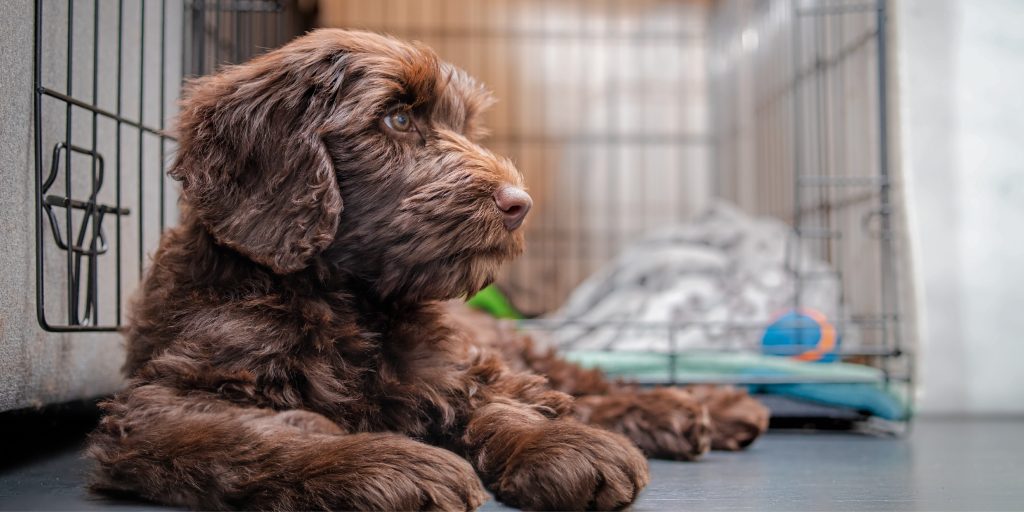Crate training can be one of the best things you do for your dog, turning their crate into a personal cozy retreat. Not only does it help with house training by teaching them boundaries, but it also gives them a safe space to relax and unwind, reducing anxiety.
The key to success? Make the process fun and stress-free as possible for both you and your pup! With the right approach, your dog will see their crate as a place of comfort rather than confinement. Let’s explore how you can turn crate training into an easy, enjoyable experience for both you and your furry friend!
Choosing the Right Crate
Picking the right crate is like finding the perfect home for your dog. There are a few different types to consider:
- Wire crates
- Offers great airflow, but pup can feel exposed
- Typically come with dividers to grow with them
- Easy assembly and cleaning
- Covers available to offer more privacy & visual appeal
- Plastic Crates
- Bulkier but cozy & easy to clean
- Typically, well ventilated and harder to escape from
- Depending on regulations, many be used for travel as well
- Wood Crates
- The most visually appealing, can blend in with furniture
- Typically, heavier and harder to clean
- More work involved in assembly
- Fabric Crates
- Light and durable
- Easy to assemble and disassemble for storage
- Consider ventilation as it varies
- Not a good option for chewers
Each type of crate has its perks—just find what suits your and your dog’s style!

Finding the Right Size
Make sure the crate is large enough for your dog to stand, turn around, lie down, and stretch out comfortably. Too small, and it feels cramped; too big, and you may risk accidents in the crate. This is where crate dividers come in handy so the space can grow with your pup.
It is a great idea to measure your dog to ensure the crate is a suitable size. With them standing, you can measure their length from the tip of their nose to the tip of their tail. You can measure height while they are sitting, by measuring from the top of their head to where their front feet meet the floor. You would then add 3-4 inches to each measurement to ensure optimal comfort!
Location is Key
Pick a spot that’s quiet but still part of the family action, like a cozy corner in the living room/family room. Always leave the door(s) open so then can freely go in and out of their safe space. Your pup will be more likely to relax in their crate when they can still hear you and be around you.
For safety reasons, you want to keep them out of direct sunlight and away from heating sources. Even in the winter, our pets can easily overheat, and they would not have the ability to move away from it.
Making the Crate Inviting
It’s important to make the crate feel comfy and inviting, like a cozy retreat, rather than cold and isolating, so your dog sees it as a safe, happy space to relax!
Creating a Cozy Environment
Transform your dog’s crate into a comfy hideaway by adding soft bedding, pet blankets or a cozy mat, but keep your pup’s behavior in mind! If your dog loves to chew or shred, opt for more durable, chew-resistant materials to prevent any destruction or emergency vet visits. Some dogs prefer the cooler surface and may even do better without blankets or beds.
Add a few favourite toys for entertainment, but also consider calming tools like soothing sounds and pheromone sprays designed to reduce anxiety and create a sense of calm. Many pet parents will leave the radio or tv on, so they don’t feel as alone.
If suitable, you can keep some of their toys or bedding in bed with you for a night before adding to the crate so they can find comfort in your smell. These small touches can make the crate feel extra safe and relaxing, turning it into the ultimate retreat for your pup!
Positive Introductions
Getting your pup comfortable in a crate, young and old, can take anywhere from a few minutes to several days and is very dependent on their comfortability and past experiences. Patience will be the most important thing.
At first, we would recommend tossing a couple treats they like into the crate, and see how comfortable they are going in. All doors should be open to ensure they don’t feel like they will get trapped. If they do go in, give lots of praise but be careful not to spook them. You can do this a few times and then leave the door open for them to explore at their own pace.
We can also introduce them with play time. Encourage playtime around the crate, progressing closer and closer to the crate. Have them play inside the crate with toys and treats. Hide and seek games with treats is a fantastic idea to get them used to being inside of it. We can start to introduce command training to go into their crates with “on your bed” or “in your crate” “crate time”, etc.

One of the best ways to get them used to their crate is feeding their meals in them. This all helps them associate their crate with positive activities like food and playtime. It is crucial to not treat the crate as a place of punishment as they will associate it with being in trouble instead of the safe haven it is meant to be.
Fun Ways to Encourage Crate Time
Interactive Toys & Puzzle Feeders
Make crate time exciting by introducing interactive toys and puzzle feeders! These toys keep your pup mentally engaged, happy and relaxed while in the crate. A puzzle feeder or snuffle mat filled with treats keeps them busy and creates positive associations with crate time.
Rotate toys to keep things fresh, and your dog will quickly see their crate as a fun, rewarding space rather than just a nap spot. The more engaging you make it, the more they’ll look forward to spending time in their cozy den!

Treats & Chews
Crate time doesn’t have to be boring—toss in a favourite high value treat or chew to make it extra enjoyable! Long-lasting chews, like bully sticks or bones, keep your pup entertained and happy in their crate.
Just remember, safety first! Always supervise while they’re chewing, especially their first time with a new toy or treat. This ensures they are playing safely, and nothing gets swallowed or broken off that shouldn’t be.
This is meant for crate training when you’re home and helping them get comfortable—it’s all about building positive associations before you start leaving them alone.
Crating Routine
Once they are more comfortable in their crate, eating their meals and taking their naps inside, we can start closing the door. When eating or snoozing, you will close the door but open it and letting them outside as soon as they finish or wake up. Gradually increase the time they stay in the crate with the door shut, helping them get used to it.
Once they’re comfortable with the door closed while eating or sleeping, practice leaving them in the crate with a toy or chew for short periods while you’re in another room. Plan this for after playtime or a walk, when they’re tired and more likely to settle down. Keep gradually increasing the time, and once they’re fully comfortable, you can start scheduling crate time for when you leave the house.
When first leaving the house do not make a big fuss about it and get them excited right before. This can result in more anxiety. Have them enter their crate, provide a toy, chew, or treat with a calm goodbye. Keep the time your away short, 5–10-minute coffee run or walk to get the mail.
Gradually increasing the time to errands, sit down dinner, or a movie. Pay attention to their behaviour and if they are becoming hesitant of their crate, you may be moving too fast for them. Revert back to the step they were last comfortable and progress slowly.
Extra Tips

- Whining
- Whining right after being put in the crate, most likely seeking attention and will relax and fall asleep shortly
- Whining or barking in the middle of the night could be a sign of discomfort or they need to go outside
- If you give them attention or let them out every time they whine, it will reinforce the behaviour
- Anxiety
- Soothing sounds, like calming music or white noise, to create a relaxing environment in the crate.
- An item with your scent, such as a blanket, can provide reassurance.
- Try Adaptil pheromones, which mimic a mother dog’s scent to promote calmness.
- Snuggle Puppy or similar product that mimics warmth and a heartbeat.
In the journey of crate training, patience and positivity are your best friends! With a little time and effort, you can turn the crate into a cozy haven where your pup feels safe and happy.
Remember to stay consistent and keep things fun—fill it with toys, treats, and love, and soon your dog will see their crate as a special retreat. Before you know it, they’ll be wagging their tail at the sight of it, ready for some cozy crate time!












